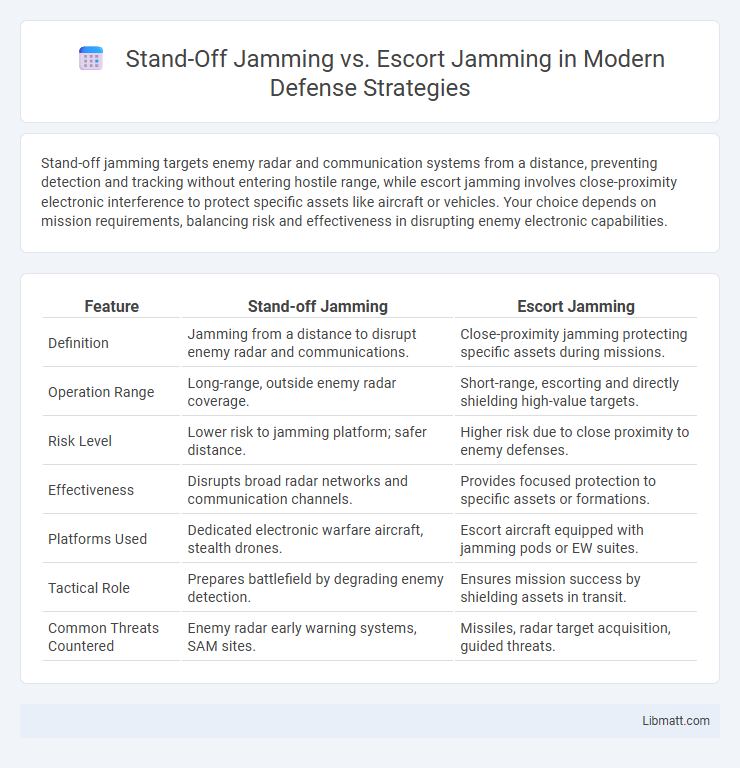Stand-off jamming targets enemy radar and communication systems from a distance, preventing detection and tracking without entering hostile range, while escort jamming involves close-proximity electronic interference to protect specific assets like aircraft or vehicles. Your choice depends on mission requirements, balancing risk and effectiveness in disrupting enemy electronic capabilities.
Table of Comparison
| Feature | Stand-off Jamming | Escort Jamming |
|---|---|---|
| Definition | Jamming from a distance to disrupt enemy radar and communications. | Close-proximity jamming protecting specific assets during missions. |
| Operation Range | Long-range, outside enemy radar coverage. | Short-range, escorting and directly shielding high-value targets. |
| Risk Level | Lower risk to jamming platform; safer distance. | Higher risk due to close proximity to enemy defenses. |
| Effectiveness | Disrupts broad radar networks and communication channels. | Provides focused protection to specific assets or formations. |
| Platforms Used | Dedicated electronic warfare aircraft, stealth drones. | Escort aircraft equipped with jamming pods or EW suites. |
| Tactical Role | Prepares battlefield by degrading enemy detection. | Ensures mission success by shielding assets in transit. |
| Common Threats Countered | Enemy radar early warning systems, SAM sites. | Missiles, radar target acquisition, guided threats. |
Introduction to Electronic Jamming Techniques
Electronic jamming techniques include stand-off jamming and escort jamming, both designed to disrupt enemy radar and communication systems. Stand-off jamming operates from a distance outside the enemy's radar detection range, effectively degrading target acquisition and tracking capabilities without direct engagement. Escort jamming, in contrast, involves close proximity to protected assets such as aircraft or convoys, providing immediate electronic countermeasures to shield them from radar-guided threats.
Overview: Stand-Off Jamming vs Escort Jamming
Stand-off jamming involves deploying jamming signals from a distance away from the protected asset, effectively disrupting enemy radar or communications without direct engagement. Escort jamming requires a jammer-equipped aircraft to stay close to and accompany the strike group or target, actively shielding it from enemy detection and missile guidance systems. Both techniques optimize electronic warfare by balancing range, coverage, and risk to friendly forces.
Key Principles of Stand-Off Jamming
Stand-off jamming operates by transmitting electronic signals from a safe distance outside the threat's radar detection range to disrupt enemy radar systems without exposing the jammer to direct countermeasures. It relies on high-powered, directional transmitters to saturate or confuse radar receivers, maximizing coverage while minimizing risk to the platform. Key principles include maintaining distance for survivability, employing power management to optimize signal interference, and using frequency agility to counter diverse radar threats effectively.
Core Tactics in Escort Jamming
Escort jamming primarily involves close protection of high-value assets by positioning jamming aircraft near the target to disrupt enemy radar and missile guidance systems effectively. Core tactics include synchronized maneuvers between the escort jammer and the assets, agile response to threats, and deployment of broadband or spot jamming techniques tailored to specific radar frequencies. This approach contrasts with stand-off jamming by emphasizing proximity and dynamic interaction with both the protected units and incoming threats to maximize electronic interference and survivability.
Advantages of Stand-Off Jamming
Stand-off jamming offers the advantage of engaging enemy radar and communication systems from a safe distance, reducing the risk to the jamming platform. It minimizes the likelihood of detection and counterattack, increasing mission survivability. This method also allows simultaneous protection of multiple assets without entering the hostile radar's effective range.
Benefits of Escort Jamming
Escort jamming provides targeted protection by closely accompanying high-value aircraft, effectively masking them from enemy radar and missile tracking systems. This approach enhances mission success rates by disrupting adversary defenses with precision, minimizing collateral electronic interference in surrounding areas. Escort jamming also enables dynamic adaptation to evolving threats, maintaining continuous coverage and operational flexibility.
Limitations and Risks of Stand-Off Jamming
Stand-off jamming faces limitations in range and effectiveness against well-defended targets, often requiring precise intelligence to avoid signal attenuation or countermeasures. The risk of detection and location by enemy forces increases as jamming signals can give away your position, potentially compromising mission security. Moreover, stand-off jamming may have limited impact against frequency-hopping or adaptive communications systems used by adversaries.
Challenges Associated with Escort Jamming
Escort jamming presents significant challenges including the need to closely accompany the targeted aircraft, increasing the risk of detection and exposure to enemy fire. The complexity of maintaining precise coordination between the jammer and the escorted platform requires advanced communication and navigation systems. High resource demand and vulnerability during dynamic combat environments limit the operational effectiveness of escort jamming compared to stand-off jamming methods.
Operational Scenarios: Comparing Effectiveness
Stand-off jamming is highly effective in long-range operational scenarios where jamming aircraft remain outside enemy air defense zones, minimizing risk while disrupting radar and communication systems from a distance. Escort jamming excels in close-combat environments, providing localized electronic protection for strike packages by accompanying them into hostile airspace and countering enemy radar and missile systems in real time. Comparing effectiveness, stand-off jamming offers strategic suppression over broad areas, whereas escort jamming delivers tactical defense with immediate target engagement.
Future Trends in Electronic Warfare Jamming
Future trends in electronic warfare jamming emphasize the integration of AI-driven algorithms to enhance the precision of stand-off jamming, enabling earlier threat detection and minimized risk to your assets. Escort jamming is evolving with multi-spectral capabilities that allow simultaneous protection of multiple platforms against advanced radar and missile threats. Enhanced cyber-electronic fusion techniques are set to revolutionize both stand-off and escort jamming by disrupting enemy communication networks and adaptive countermeasures.
Stand-off jamming vs Escort jamming Infographic

 libmatt.com
libmatt.com